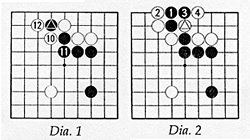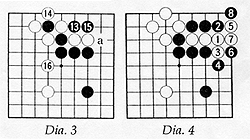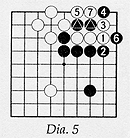Professional go in Japan
Although go was always esteemed by the upper classes in China and Korea, it was in Japan that it achieved its highest level of play and became widely popular with the masses. The game reached the zenith of its theoretical development at the end of the Edo period (1603-1868), but the prosperity it had achieved was swept away in the 1860s amid the confusion resulting from the collapse of the Tokugawa Shogunate. The system of government patronage it received was abolished in 1868, and the heads of the four go houses and their pupils found themselves adrift in a new world where ancient traditions were cast aside.Around 1880, interest in go was revived, this time under private auspices. Newspapers started publishing game records, and The Yomiuri Shimbun, nowadays a leading sponsor of go in Japan, was one of the first when it started publishing game records in 1885. By 1910, there were more than a dozen newspapers with go columns, and it became feasible to make a living as a go player again. In July 1924, the Japan Go Association was founded, and professional go in its current form began. Today, there are nearly 500 active professional players in Japan.
Professional go players can make substantial earnings through game fees and prize money from the many tournaments they compete in. In addition, they can also earn money by officiating at tournaments, making TV appearances, teaching amateurs, and receiving royalties on books and videos.
How does one become a professional go player? In Japan, the usual way is to become an apprentice at the Japan Go Association or the Western Japan Go Association. The associations usually accept only youngsters from age 5 to 18 who show exceptional talent. Every Saturday and Sunday, these young students compete with each other in a rating tournament. To qualify as professionals, they must work their way up to the upper echelons of the tournament. Out of 48 aspirants, only five are admitted to professional rank each year.
Once apprentices have become professional, they start out at the rank of 1-dan. To rise above this rank, they play against other professionals in a rating tournament. The system for gaining promotion is complicated, but, in essence, if a player wins a certain percentage of an increasing number of games, he or she will be promoted to the next rank. The highest rank attainable is 9-dan.
More about capturing
This week I am going to review the game I presented in last week's column to help you understand what to do when you find one or more of your stones threatened with capture.
 When White threatens to capture the marked stone with 12 in Diagram 1 (Figure 2 in last week's column), you might wonder why Black didn't try to escape with Black 1 in Diagram 2. If he does, he will fail. White pursues him with 2 and the two black stones are still threatened with capture. If Black persists in escaping with 3, threatening to capture the marked white stone, White takes the last liberty of this three stone group with 4 and captures three stones before Black can capture the marked white one.
When White threatens to capture the marked stone with 12 in Diagram 1 (Figure 2 in last week's column), you might wonder why Black didn't try to escape with Black 1 in Diagram 2. If he does, he will fail. White pursues him with 2 and the two black stones are still threatened with capture. If Black persists in escaping with 3, threatening to capture the marked white stone, White takes the last liberty of this three stone group with 4 and captures three stones before Black can capture the marked white one.
After Black 15 in Diagram 3 (Figure 3 in last week's column), it seems as if the two white stones in atari could escape by extending to "a." Why doesn't White try?
 White can't escape unless Black blunders. When White extends to 1 in Diagram 4, he increases his liberties to three, but Black pursues him with 2. White is at the end of his rope: He has no way to increase his liberties after Black 4. If White plays 5, Black ataris with 6 and captures with 8.
White can't escape unless Black blunders. When White extends to 1 in Diagram 4, he increases his liberties to three, but Black pursues him with 2. White is at the end of his rope: He has no way to increase his liberties after Black 4. If White plays 5, Black ataris with 6 and captures with 8.
 However, Black must not block from below with 2 in Diagram 5. White will turn at 3, and now the two marked black stones have only two liberties, while the white group on the right has three. White captures the two marked stones with 5 and 7.
However, Black must not block from below with 2 in Diagram 5. White will turn at 3, and now the two marked black stones have only two liberties, while the white group on the right has three. White captures the two marked stones with 5 and 7.
As a general rule, when your stones have no hope of escaping, it is often best to leave them as they are and play elsewhere.
